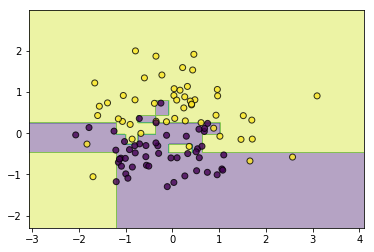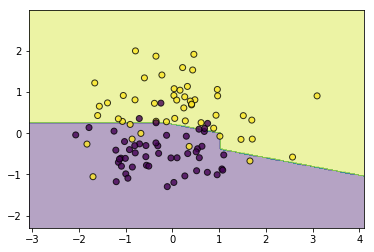《机器学习Python实现_10_06_集成学习_boosting_gbdt分类实现》
一.利用回归树实现分类
分类也可以用回归树来做,简单说来就是训练与类别数相同的几组回归树,每一组代表一个类别,然后对所有组的输出进行softmax操作将其转换为概率分布,然后再通过交叉熵或者KL一类的损失函数求每颗树相应的负梯度,指导下一轮的训练,以三分类为例,流程如下:

二.softmax+交叉熵损失,及其梯度求解
分类问题,一般会选择用交叉熵作为损失函数,下面对softmax+交叉熵损失函数的梯度做推导:
softmax函数在最大熵那一节已有使用,再回顾一下:
\]
交叉熵在logistic回归有介绍:
\]
将\(p_i\)替换为\(\frac{e^{y_i^{hat}}}{\sum_{i=1}^n e^{y_i^{hat}}}\)即是我们的损失函数:
=-\sum_{i=1}^n y_i(y_i^{hat}-log\sum_{j=1}^n e^{y_j^{hat}})\\
=log\sum_{i=1}^n e^{y_i^{hat}}-\sum_{i=1}^ny_iy_i^{hat}(由于是onehot展开,所以\sum_{i=1}^n y_i=1)
\]
计算梯度:
\]
所以,第一组回归树的拟合目标为\(y_1-\frac{e^{y_1^{hat}}}{\sum_{i=1}^n e^{y_i^{hat}}}\),第二组回归树学习的拟合目标为\(y_2-\frac{e^{y_2^{hat}}}{\sum_{i=1}^n e^{y_i^{hat}}}\),....,第\(n\)组回归树的拟合目标为\(y_n-\frac{e^{y_n^{hat}}}{\sum_{i=1}^n e^{y_i^{hat}}}\)
三.代码实现
import osos.chdir('../')from ml_models.tree import CARTRegressorfrom ml_models import utilsimport copyimport numpy as npimport matplotlib.pyplot as plt%matplotlib inlineclass GradientBoostingClassifier(object):def __init__(self, base_estimator=None, n_estimators=10, learning_rate=1.0):""":param base_estimator: 基学习器,允许异质;异质的情况下使用列表传入比如[estimator1,estimator2,...,estimator10],这时n_estimators会失效;同质的情况,单个estimator会被copy成n_estimators份:param n_estimators: 基学习器迭代数量:param learning_rate: 学习率,降低后续基学习器的权重,避免过拟合"""self.base_estimator = base_estimatorself.n_estimators = n_estimatorsself.learning_rate = learning_rateif self.base_estimator is None:# 默认使用决策树桩self.base_estimator = CARTRegressor(max_depth=2)# 同质分类器if type(base_estimator) != list:estimator = self.base_estimatorself.base_estimator = [copy.deepcopy(estimator) for _ in range(0, self.n_estimators)]# 异质分类器else:self.n_estimators = len(self.base_estimator)# 扩展class_num组分类器self.expand_base_estimators = []def fit(self, x, y):# 将y转one-hot编码class_num = np.amax(y) + 1y_cate = np.zeros(shape=(len(y), class_num))y_cate[np.arange(len(y)), y] = 1# 扩展分类器self.expand_base_estimators = [copy.deepcopy(self.base_estimator) for _ in range(class_num)]# 拟合第一个模型y_pred_score_ = []# TODO:并行优化for class_index in range(0, class_num):self.expand_base_estimators[class_index][0].fit(x, y_cate[:, class_index])y_pred_score_.append(self.expand_base_estimators[class_index][0].predict(x))y_pred_score_ = np.c_[y_pred_score_].T# 计算负梯度new_y = y_cate - utils.softmax(y_pred_score_)# 训练后续模型for index in range(1, self.n_estimators):y_pred_score = []for class_index in range(0, class_num):self.expand_base_estimators[class_index][index].fit(x, new_y[:, class_index])y_pred_score.append(self.expand_base_estimators[class_index][index].predict(x))y_pred_score_ += np.c_[y_pred_score].T * self.learning_ratenew_y = y_cate - utils.softmax(y_pred_score_)def predict_proba(self, x):# TODO:并行优化y_pred_score = []for class_index in range(0, len(self.expand_base_estimators)):estimator_of_index = self.expand_base_estimators[class_index]y_pred_score.append(np.sum([estimator_of_index[0].predict(x)] +[self.learning_rate * estimator_of_index[i].predict(x) for i inrange(1, self.n_estimators - 1)] +[estimator_of_index[self.n_estimators - 1].predict(x)], axis=0))return utils.softmax(np.c_[y_pred_score].T)def predict(self, x):return np.argmax(self.predict_proba(x), axis=1)
#造伪数据from sklearn.datasets import make_classificationdata, target = make_classification(n_samples=100, n_features=2, n_classes=2, n_informative=1, n_redundant=0,n_repeated=0, n_clusters_per_class=1, class_sep=.5,random_state=21)
# 同质classifier = GradientBoostingClassifier(base_estimator=CARTRegressor(),n_estimators=10)classifier.fit(data, target)utils.plot_decision_function(data, target, classifier)

#异质from ml_models.linear_model import LinearRegressionclassifier = GradientBoostingClassifier(base_estimator=[LinearRegression(),LinearRegression(),LinearRegression(),CARTRegressor(max_depth=2)])classifier.fit(data, target)utils.plot_decision_function(data, target, classifier)

《机器学习Python实现_10_06_集成学习_boosting_gbdt分类实现》的更多相关文章
- 简单物联网:外网访问内网路由器下树莓派Flask服务器
最近做一个小东西,大概过程就是想在教室,宿舍控制实验室的一些设备. 已经在树莓上搭了一个轻量的flask服务器,在实验室的路由器下,任何设备都是可以访问的:但是有一些限制条件,比如我想在宿舍控制我种花 ...
- 利用ssh反向代理以及autossh实现从外网连接内网服务器
前言 最近遇到这样一个问题,我在实验室架设了一台服务器,给师弟或者小伙伴练习Linux用,然后平时在实验室这边直接连接是没有问题的,都是内网嘛.但是回到宿舍问题出来了,使用校园网的童鞋还是能连接上,使 ...
- 外网访问内网Docker容器
外网访问内网Docker容器 本地安装了Docker容器,只能在局域网内访问,怎样从外网也能访问本地Docker容器? 本文将介绍具体的实现步骤. 1. 准备工作 1.1 安装并启动Docker容器 ...
- 外网访问内网SpringBoot
外网访问内网SpringBoot 本地安装了SpringBoot,只能在局域网内访问,怎样从外网也能访问本地SpringBoot? 本文将介绍具体的实现步骤. 1. 准备工作 1.1 安装Java 1 ...
- 外网访问内网Elasticsearch WEB
外网访问内网Elasticsearch WEB 本地安装了Elasticsearch,只能在局域网内访问其WEB,怎样从外网也能访问本地Elasticsearch? 本文将介绍具体的实现步骤. 1. ...
- 怎样从外网访问内网Rails
外网访问内网Rails 本地安装了Rails,只能在局域网内访问,怎样从外网也能访问本地Rails? 本文将介绍具体的实现步骤. 1. 准备工作 1.1 安装并启动Rails 默认安装的Rails端口 ...
- 怎样从外网访问内网Memcached数据库
外网访问内网Memcached数据库 本地安装了Memcached数据库,只能在局域网内访问,怎样从外网也能访问本地Memcached数据库? 本文将介绍具体的实现步骤. 1. 准备工作 1.1 安装 ...
- 怎样从外网访问内网CouchDB数据库
外网访问内网CouchDB数据库 本地安装了CouchDB数据库,只能在局域网内访问,怎样从外网也能访问本地CouchDB数据库? 本文将介绍具体的实现步骤. 1. 准备工作 1.1 安装并启动Cou ...
- 怎样从外网访问内网DB2数据库
外网访问内网DB2数据库 本地安装了DB2数据库,只能在局域网内访问,怎样从外网也能访问本地DB2数据库? 本文将介绍具体的实现步骤. 1. 准备工作 1.1 安装并启动DB2数据库 默认安装的DB2 ...
- 怎样从外网访问内网OpenLDAP数据库
外网访问内网OpenLDAP数据库 本地安装了OpenLDAP数据库,只能在局域网内访问,怎样从外网也能访问本地OpenLDAP数据库? 本文将介绍具体的实现步骤. 1. 准备工作 1.1 安装并启动 ...
随机推荐
- 剑指 Offer 26. 树的子结构
剑指 Offer 26. 树的子结构 Offer 26 题目详情: 题解分析 解法一: 第一种比较容易想到的解法就是查看这两棵树的前序遍历和中序遍历序列是否都匹配. 因为前序遍历和中序遍历可以唯一确定 ...
- 剑指 Offer 10- II. 青蛙跳台阶问题
剑指 Offer 10- II. 青蛙跳台阶问题 Offer 10- II 题目描述: 动态规划方程: 循环求余: 复杂度分析: package com.walegarrett.offer; impo ...
- POJ-3259(最短路+Bellman-Ford算法判负圈)
Wormholes POJ-3259 这题是最短路问题中判断是否存在负圈的模板题. 判断负圈的一个关键就是理解:如果在图中不存在从s可达的负圈,最短路径不会经过一个顶点两次.while循环最多执行v- ...
- PHP中一些常用的安全类函数
(1) htmlspecialchars() 表单验证(验证表单中的数据是否为空以及提交的数据是否合法) htmlspecialchars() //该函数将预定义的字符转化为html实体,预定义的 ...
- 200-Java语言基础-Java编程入门-004 | Java分支与循环
一.流程控制语句 可以控制程序的执行流程 在程序开发的过程之中一共会存在有三种程序逻辑:顺序结构.条件分支(选择)结构.循环结构. 顺序结构的定义,即:所有的程序将按照定义的代码从上往下.顺序依次执行 ...
- 使用伪类(::before/::after)设置图标
使用伪类(::before/::after)设置文本前后图标.减少标签的浪费,使页面更加整洁. 如图: <!DOCTYPE html> <html> <head> ...
- Tex中的引号(JAVA语言)
package 第三章; import java.util.Scanner; public class Tex中的引号 { public static void main(String[] args) ...
- 攻防世界 reverse 进阶 16-zorropub
16.zorropub nullcon-hackim-2016 (linux平台以后整理) https://github.com/ctfs/write-ups-2016/tree/master/nu ...
- gstreamer常用命令
由于有好一段时间没做GStreamer相关项目了,早前的一些记录需要做下记录,以待需要的时候查阅. 还是分几个小节来介绍吧,这样思路清晰一点.(格式有点乱,没时间整理,读者自行脑补) 1. 播放视频. ...
- LinkedList类详解
LinkedList类中的方法与实现原理 目录 一.数据结构 二.类标题 三.字段 四.构造函数 五.方法分析 5.1 共有方法 public boolean add(Object o) public ...
